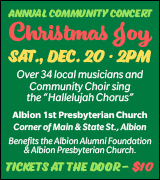Oak Orchard Swamp bird count planned for Dec. 27
Residents urged to fill bird feeders ahead of the count

Photos courtesy of Celeste Morien: An Eastern Screech-Owl is shown on a wintry day.
By Celeste Morien, count compiler for Oak Orchard Swamp Christmas Bird Count
BASOM – It’s almost time for the Oak Orchard Swamp Christmas Bird Count!
The count began in December 1968. The National Audubon Society has been sponsoring Christmas Bird Counts since their inception. Count compiler and Medina resident Celeste Morien would like the public to be alert for counters with spotting scopes and binoculars who will be out Dec. 27 on local roads, searching for birds in fields and at bird feeders.

Downy Woodpecker
Filling bird feeders now and keeping them stocked ahead of the count helps fulfill the count objective of counting all wild birds seen and heard within the circle. The Oak Orchard Swamp count circle is centered at the Iroquois National Wildlife Refuge on the Orleans and Genesee County line at Route 63.
Count volunteers follow routes through a designated 15-mile diameter circle, which includes more than the refuge and state wildlife areas, counting every bird they see or hear all day. It’s not just a species tally; individual birds are counted, giving an indication of the total number of birds per species in the circle that day.
If you are at home on count day within the circle, you may report the birds that visit your feeders. To do so, please contact celeste.morien@gmail.com. (See map)
According to the Audubon website, “Prior to the turn of the 20th century, hunters engaged in a holiday tradition known as the Christmas “Side Hunt.” They would choose sides and go afield with their guns—whoever brought in the biggest pile of feathered (and furred) quarry won.
Conservation was in its beginning stages in that era, and many observers and scientists were becoming concerned about declining bird populations. Beginning on Christmas Day 1900, ornithologist Frank M. Chapman, an early officer in the then-nascent Audubon Society, proposed a new holiday tradition—a “Christmas Bird Census” that would count birds during the holidays rather than hunt them.
So began the Christmas Bird Count. Thanks to the inspiration of Chapman and the enthusiasm of 27 dedicated birders, 25 Christmas Bird Counts were held that day. The locations ranged from Toronto, Ontario to Pacific Grove, California.
From Dec. 14 through Jan. 5 each year tens of thousands of volunteers throughout North America, Latin America, the Caribbean and Pacific Islands brave snow, wind, or rain, and take part in the effort. Audubon and other organizations use data collected in this long-running wildlife census to assess the health of bird populations, and to help guide conservation action.

Black-capped Chickadees are shown at a bird feeder.
The data collected by observers over the past century allow Audubon researchers, conservation biologists, wildlife agencies and other interested individuals to study the long-term health and status of bird populations across North America. When combined with other surveys such as the Breeding Bird Survey, it provides a picture of how the continent’s bird populations have changed over the past hundred years.
The long term perspective is vital for conservationists. It informs strategies to protect birds and their habitat, and helps identify environmental issues with implications for people as well.
Please consider donating to the Christmas Count here since the Audubon Society no longer collects fees from each participant.
For past results of any Christmas Bird Count, the National Audubon Society website is an excellent resource.






























































